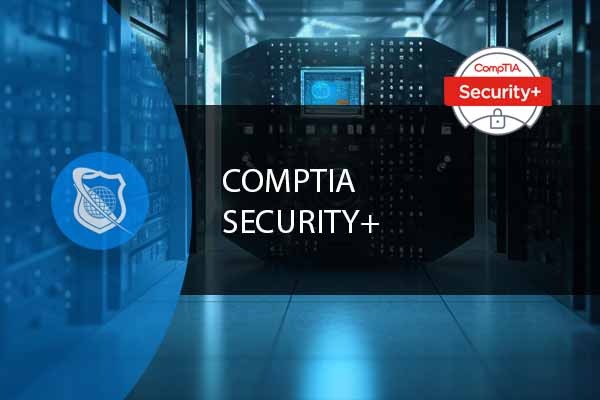The Imperative of Identity and Access Management in CompTIA Security +
Welcome to the fifth installment of our 7-part series focused on CompTIA Security +. Today’s topic is a domain that often serves as the backbone of any robust cybersecurity strategy: “4.0 Identity and Access Management.” This domain is not just a set of exam objectives; it’s a critical area that impacts the security posture of organizations across industries. By the end of this blog, you’ll have a comprehensive understanding of why Identity and Access Management is indispensable, both for acing your CompTIA Security + exam and for implementing effective cybersecurity measures in real-world scenarios.
| Domain | Percentage of Examination | Key Subtopics |
|---|---|---|
| 1.0 Threats, Attacks and Vulnerabilities | 21% | Malware Types, Types of Attacks, Threat Actors |
| 2.0 Technologies and Tools | 22% | Network Components, Software Tools, Troubleshooting |
| 3.0 Architecture and Design | 15% | Frameworks, Network Architecture, Systems Design |
| 4.0 Identity and Access Management | 16% | AAA, Multifactor Authentication, Account Management |
| 5.0 Risk Management | 14% | Policies, Business Impact, Risk Assessment |
| 6.0 Cryptography and PKI | 12% | Symmetric Algorithms, Asymmetric Algorithms, Hashing |
Secure Your Networks and Prevent Password Breaches
Our robust CompTIA Sec+ course is the perfect resouce to ensure your company’s most valuable assets are safe. Up your security skills with this comprehensive course at an exceptional price.
Why Identity and Access Management is Crucial in CompTIA Security +
Identity and Access Management (IAM) is more than just a buzzword; it’s the cornerstone of any effective cybersecurity strategy. In the context of CompTIA Security +, this domain takes on a special significance as it forms the basis for controlling who gets access to what within an organization. It’s the mechanism that ensures only authorized individuals—be they employees, contractors, or clients—have the appropriate access to specific resources, be it data, systems, or applications.
But mastering IAM goes beyond just preparing for your CompTIA Security + exam. In a world where cybersecurity threats are continually evolving, having a robust IAM strategy is your first line of defense against unauthorized access and potential data breaches. It’s about implementing policies and procedures that are not only robust but also adaptable to changing threat landscapes. This adaptability is what makes IAM a continually relevant and critical domain in CompTIA Security +, as well as in the broader field of cybersecurity.
Core Concepts in Identity and Access Management
Authentication Methods: The First Line of Defense
Authentication serves as the initial step in the Identity and Access Management (IAM) process. It’s the mechanism that verifies the identity of a user, application, or device before granting access to a system. Various methods can be employed for authentication, such as passwords, biometrics, and multi-factor authentication (MFA). Understanding these methods is not just essential for passing the CompTIA Security + exam; it’s also critical for implementing a secure authentication strategy in real-world scenarios.
Authorization and Permissions: Beyond the Login
Once a user or system is authenticated, the next layer in IAM is authorization. This involves assigning permissions and access levels based on predefined policies or roles. For instance, an HR representative might have access to employee records but not financial data. Understanding how to set up and manage these permissions is a crucial aspect of effective IAM. It’s a topic that is covered extensively in the CompTIA Security + curriculum, emphasizing its importance in both exam preparation and practical application.
Identity Federation and Single Sign-On: Simplifying Access Across Systems
In today’s interconnected world, users often need to access multiple systems, sometimes across different organizations. This is where advanced IAM concepts like identity federation and Single Sign-On (SSO) come into play. These technologies allow for seamless and secure access across various platforms and are becoming increasingly important in complex IT environments. Both identity federation and SSO are key topics in the CompTIA Security + exam, highlighting their relevance in modern cybersecurity strategies.
Secure Your Networks and Prevent Password Breaches
Our robust CompTIA Sec+ course is the perfect resouce to ensure your company’s most valuable assets are safe. Up your security skills with this comprehensive course at an exceptional price.
Best Practices in Identity and Access Management
Principle of Least Privilege: Minimizing Risk
The principle of least privilege is a cornerstone in the realm of Identity and Access Management (IAM). It’s a simple yet effective concept: grant users only the permissions they absolutely need to perform their tasks. This minimizes the risk of unauthorized access and potential data breaches. While this principle is a fundamental aspect of IAM, it’s also emphasized in the CompTIA Security + curriculum, making it essential for both exam preparation and real-world application.
Multi-Factor Authentication (MFA): Adding Layers of Security
Multi-Factor Authentication (MFA) is more than just a buzzword; it’s a best practice that adds an extra layer of security to the authentication process. By requiring two or more forms of verification—something you know (like a password), something you have (like a mobile device), or something you are (like a fingerprint)—MFA makes it significantly more challenging for unauthorized users to gain access. This practice is highly recommended in CompTIA Security + and is becoming a standard requirement in many industry regulations.
Regular Audits and Monitoring: Keeping an Eye on Access
Regular audits and monitoring are crucial for maintaining a secure IAM environment. By routinely checking access logs and user activities, organizations can quickly detect any unauthorized access or suspicious behavior. This proactive approach is not just a recommendation in the CompTIA Security + guidelines; it’s also considered a standard industry practice. Regular audits can help organizations stay compliant with various regulations and can serve as an early warning system against potential security incidents.
Real-world Applications: Beyond the CompTIA Security + Exam
Mastering the principles of Identity and Access Management (IAM) has far-reaching implications that extend well beyond the scope of the CompTIA Security + exam. Whether you’re an IT manager overseeing a small business network or a Chief Information Security Officer (CISO) responsible for a multinational corporation, the best practices and core concepts you learn in the CompTIA Security + curriculum are directly applicable to your day-to-day operations. From implementing robust authentication methods to conducting regular security audits, the skills you acquire are invaluable for maintaining a secure and compliant organizational environment.
Conclusion: The Pivotal Role of Identity and Access Management in CompTIA Security +
As we wrap up this comprehensive exploration of Identity and Access Management, one thing becomes abundantly clear: IAM is far more than just a set of theories to memorize for an exam. It’s a practical, hands-on skill set that plays a pivotal role in shaping an organization’s cybersecurity strategy. The principles and best practices covered in this blog—and emphasized in the CompTIA Security + guidelines—equip you with the knowledge and skills needed to implement effective IAM policies. So, as you prepare for your CompTIA Security + exam, know that you’re also arming yourself with essential skills that will serve you well in the ever-evolving landscape of cybersecurity.
CompTIA Security+ Identity and Access Management FAQ
What is Identity and Access Management (IAM) in CompTIA Security+?
Identity and Access Management (IAM) in CompTIA Security+ refers to a framework of policies and technologies for ensuring that the right users have the appropriate access to technology resources. IAM systems provide tools for tracking user activities, enforcing security policies, and managing user identities and access rights, thereby securing an organization’s data and resources.
How does IAM contribute to an organization’s security posture according to CompTIA Security+?
IAM significantly enhances an organization’s security posture by ensuring that only authorized users can access certain data and resources. It employs authentication methods such as passwords, biometrics, and two-factor authentication to verify user identities. Moreover, IAM systems allow for detailed auditing and reporting, which helps in detecting and mitigating potential security threats, aligning with CompTIA Security+ standards for robust cybersecurity measures.
What are the key components of IAM systems in the context of CompTIA Security+?
The key components of IAM systems, as outlined in CompTIA Security+, include:
User Provisioning: The process of creating, managing, and disabling user accounts and access rights.
Authentication and Authorization: Verifying user identities and ensuring they have access only to what they are allowed.
Directory Services: Databases that store and manage user information and privileges.
Access Management: The enforcement of security policies that determine who is allowed to access which resources.
Audit and Compliance Reporting: Tools for monitoring and recording access and activities to ensure compliance with security policies and regulations.
Can IAM systems help in complying with regulatory requirements, according to CompTIA Security+ guidelines?
Yes, IAM systems play a crucial role in helping organizations comply with regulatory requirements. By controlling and monitoring access to sensitive information, IAM systems ensure that data is only accessible to authorized users, thereby supporting compliance with laws and regulations like GDPR, HIPAA, and SOX. CompTIA Security+ emphasizes the importance of IAM in maintaining data privacy and security standards required by these regulations.
What are the challenges in implementing IAM solutions, and how does CompTIA Security+ suggest addressing them?
Implementing IAM solutions comes with challenges such as managing complex user roles, handling the integration of IAM with existing systems, and ensuring user convenience without compromising security. CompTIA Security+ suggests addressing these challenges by adopting a phased implementation approach, ensuring scalability, utilizing federated identity management for easier integration, and constantly updating security measures to address evolving threats. Regular training and awareness programs are also recommended to ensure users understand their role in maintaining security.
Secure Your Networks and Prevent Password Breaches
Our robust CompTIA Sec+ course is the perfect resouce to ensure your company’s most valuable assets are safe. Up your security skills with this comprehensive course at an exceptional price.
Explore Our Comprehensive 6-Part Series on CompTIA Network+ Exam Domains
Dive deep into the world of networking with our extensive 6-part blog series designed to be your ultimate guide for the CompTIA A+ Exam. Each blog focuses on a specific domain, providing expert insights, study tips, and real-world applications to help you master the subject and ace the exam. Click on the titles below to explore each domain in detail.
CompTIA Security+ Certification: Your Ultimate Guide (1 of 7 Part Series)
CompTIA Security+ Objectives : Threats, Attacks and Vulnerabilities (2 of 7 Part Series)
CompTIA Security: Technologies and Tools (3 of 7 Part Series)
Security CompTIA : Architecture and Design (4 of 7 Part Series)
CompTIA Security +: Identity and Access Management (5 of 7 Part Series)
CompTIA Security Plus : Risk Management (6 of 7 Part Series)
Security CompTIA + : Cryptography and PKI (7 of 7 Part Series)
























